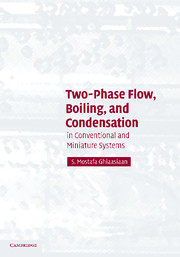Book contents
- Frontmatter
- Contents
- Preface
- Frequently Used Notation
- TWO-PHASE FLOW, BOILING AND CONDENSATION IN CONVENTIONAL AND MINIATURE SYSTEMS
- PART ONE TWO-PHASE FLOW
- PART TWO BOILING AND CONDENSATION
- 11 Pool Boiling
- 12 Flow Boiling
- 13 Critical Heat Flux and Post-CHF Heat Transfer in Flow Boiling
- 14 Flow Boiling and CHF in Small Passages
- 15 Fundamentals of Condensation
- 16 Internal-Flow Condensation and Condensation on Liquid Jets and Droplets
- 17 Choking in Two-Phase Flow
- APPENDIX A Thermodynamic Properties of Saturated Water and Steam
- APPENDIX B Transport Properties of Saturated Water and Steam
- APPENDIX C Thermodynamic Properties of Saturated Liquid and Vapor for Selected Refrigerants
- APPENDIX D Properties of Selected Ideal Gases at 1 Atmosphere
- APPENDIX E Binary Diffusion Coefficients of Selected Gases in Air at 1 Atmosphere
- APPENDIX F Henry's Constant of Dilute Aqueous Solutions of Selected Substances at Moderate Pressures
- APPENDIX G Diffusion Coefficients of Selected Substances in Water at Infinite Dilution at 25°C
- APPENDIX H Lennard–Jones Potential Model Constants for Selected Molecules
- APPENDIX I Collision Integrates for the Lennard–Jones Potential Model
- APPENDIX J Physical Constants
- APPENDIX K Unit Conversions
- References
- Index
16 - Internal-Flow Condensation and Condensation on Liquid Jets and Droplets
- Frontmatter
- Contents
- Preface
- Frequently Used Notation
- TWO-PHASE FLOW, BOILING AND CONDENSATION IN CONVENTIONAL AND MINIATURE SYSTEMS
- PART ONE TWO-PHASE FLOW
- PART TWO BOILING AND CONDENSATION
- 11 Pool Boiling
- 12 Flow Boiling
- 13 Critical Heat Flux and Post-CHF Heat Transfer in Flow Boiling
- 14 Flow Boiling and CHF in Small Passages
- 15 Fundamentals of Condensation
- 16 Internal-Flow Condensation and Condensation on Liquid Jets and Droplets
- 17 Choking in Two-Phase Flow
- APPENDIX A Thermodynamic Properties of Saturated Water and Steam
- APPENDIX B Transport Properties of Saturated Water and Steam
- APPENDIX C Thermodynamic Properties of Saturated Liquid and Vapor for Selected Refrigerants
- APPENDIX D Properties of Selected Ideal Gases at 1 Atmosphere
- APPENDIX E Binary Diffusion Coefficients of Selected Gases in Air at 1 Atmosphere
- APPENDIX F Henry's Constant of Dilute Aqueous Solutions of Selected Substances at Moderate Pressures
- APPENDIX G Diffusion Coefficients of Selected Substances in Water at Infinite Dilution at 25°C
- APPENDIX H Lennard–Jones Potential Model Constants for Selected Molecules
- APPENDIX I Collision Integrates for the Lennard–Jones Potential Model
- APPENDIX J Physical Constants
- APPENDIX K Unit Conversions
- References
- Index
Summary
Introduction
Internal-flow condensation is encountered in refrigeration and air-conditioning systems and during some accident scenarios in nuclear reactor coolant systems. Internal-flow condensation leads to a two-phase flow with some complex flow patterns. The condensing two-phase flows have some characteristics that are different from other commonly encountered two-phase flows. Empirical correlations are available for pure vapors condensing in some simple basic geometries (e.g., horizontal circular channels). Heat transfer (condensation rate) and hydrodynamics are strongly coupled and are sensitive to the two-phase flow regime. The two-phase flow regimes themselves depend on the orientation of the flow passage with respect to gravity.
Internal–flow condenser passages are usually designed to support vertical downward flow, inclined downward flow, or horizontal flow. Configurations that can lead to unfavorable hydrodynamics (e.g., countercurrent flow limitation and loop seal effect) are avoided in these systems. As a result, most of the published experimental studies and analytical models cover vertical downflow, and horizontal flow. Condensation in unfavorable configurations can be encountered during off–normal and accident conditions of many systems, however.
Shell-side phenomena in shell-and-tube-type condensers will not be discussed in this chapter. Complex three–dimensional flow is encountered in large power plant condensers. In these condensers the condensing fluid (steam) typically flows in the shell side of the shell–and–tube-type heat exchangers, with the secondary coolant flowing inside the tubes. The shell-side flow and condensation processes have certain common features with both internal and external condensing flows. Marto (1984, 1988) has written some useful reviews of these condensers.
- Type
- Chapter
- Information
- Two-Phase Flow, Boiling, and CondensationIn Conventional and Miniature Systems, pp. 462 - 498Publisher: Cambridge University PressPrint publication year: 2007



